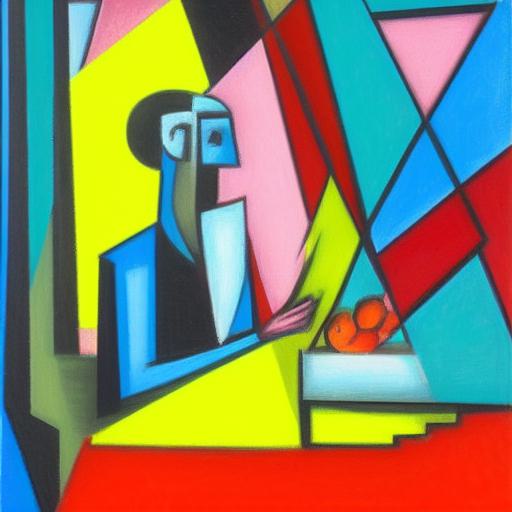How to write this prompt?
Here is a breakdown of the elements in the prompt and how they influence the image being generated:
- Neon Tone: This sets the overall color scheme for the image, which will be bright and vibrant, with bold colors and strong contrasts.
- Cubism Painting: This tells the AI to generate an image in the style of cubism, which is characterized by the use of geometric shapes and fragmented forms to create a complex and dynamic image.
- Beautiful Man Sitting at a Table with Fruit Trees: This provides a specific subject for the image, which will be a man sitting at a table surrounded by fruit trees. This could inspire the AI to create a scene that evokes a sense of calm and tranquility.
- A Cubist Painting by Bernard Accama: This is a reference to a specific artist and their style of cubism, which could influence the AI to create an image that is similar in style and technique to Accama’s work.
- Tumblr: This could be a reference to a specific aesthetic or style that is popular on the Tumblr platform, which could influence the AI to create an image that is visually appealing to a Tumblr audience.
- Figurative Art: This is a reference to the style of art that focuses on the human figure and form, which could influence the AI to create an image that emphasizes the man’s body and features.
- Cubists Love It: This is a reference to the fact that cubism is a popular style among art enthusiasts and collectors, which could inspire the AI to create an image that is aesthetically pleasing and appealing to a wide audience.
- Picasso Style: This is a reference to the style of cubism popularized by the artist Pablo Picasso, which could influence the AI to create an image that incorporates elements of Picasso’s style, such as the use of bold colors and angular forms.
All of these elements work together to provide the AI with specific parameters and inspiration for generating an image that is in line with the desired style and subject matter. By providing a clear and detailed prompt, the AI can create an image that meets the specific requirements and expectations of the user.
What is the significance of neon tones in art?
Neon tones are bright and vibrant, and they can add a sense of energy and excitement to an artwork. They are often associated with the pop art movement and can be used to create a sense of playfulness or irony.
How to create a cubist painting?
To create a cubist painting, you will need to break down the subject into geometric shapes and fragmented forms, and then reassemble them into a complex and dynamic composition. This can be achieved through the use of overlapping planes, multiple perspectives, and a limited color palette.
Who is Bernard Accama?
Bernard Accama was a Dutch painter who was active in the early 20th century. He was known for his cubist paintings, which were characterized by the use of geometric shapes and fragmented forms to create complex and dynamic images. His work was influenced by the art of Pablo Picasso and Georges Braque, and he was a key figure in the development of cubism in the Netherlands.
What are some examples of AI-generated art?
There are many examples of AI-generated art that showcase the capabilities of artificial intelligence in creating original works of art. Here are a few examples:
- The Next Rembrandt: In 2016, a team of artists and developers used machine learning algorithms to create a new painting in the style of Rembrandt. The painting was created using data from Rembrandt’s existing works, including brushstrokes, color palettes, and compositional elements.
- AICAN: AICAN is an AI system that has been trained to create abstract paintings. The system was created by Rutgers University professor Ahmed Elgammal, and it uses deep learning algorithms to analyze and generate new images based on patterns and relationships in existing works of art.
- DeepDream: DeepDream is a program developed by Google that uses a neural network to create abstract images based on patterns and features in existing images. The program has been used to create everything from psychedelic landscapes to surreal animal portraits.
Are there any ethical concerns related to AI art generation?
As with any new technology, there are ethical concerns related to AI art generation that need to be considered. Here are a few examples:
- Ownership and attribution: Who owns the rights to an AI-generated artwork? Is it the developer who created the algorithm, the user who trained the system, or the machine itself? Additionally, how can we ensure that the creators of original works of art are properly attributed and compensated for their work?
- Bias and discrimination: AI systems are only as good as the data they are trained on. If the data used to train an AI system is biased or discriminatory, then the system itself may produce biased or discriminatory results. This could lead to perpetuating harmful stereotypes and inequalities.
- Authenticity and originality: AI-generated art is often praised for its novelty and originality, but what does it mean for a work of art to be truly “original” if it was created by a machine? Additionally, how can we distinguish between authentic and counterfeit AI-generated art, and what are the implications for the art market and for collectors?
Visual Paradigm Online is a powerful design tool that enables users to seamlessly integrate AI-generated art into their graphic designs, resulting in visually stunning and engaging graphics with just a few clicks. With its user-friendly interface and an extensive collection of design templates and assets, Visual Paradigm Online offers a convenient and effortless way to experiment with various styles and layouts until you achieve the perfect combination for your project.


